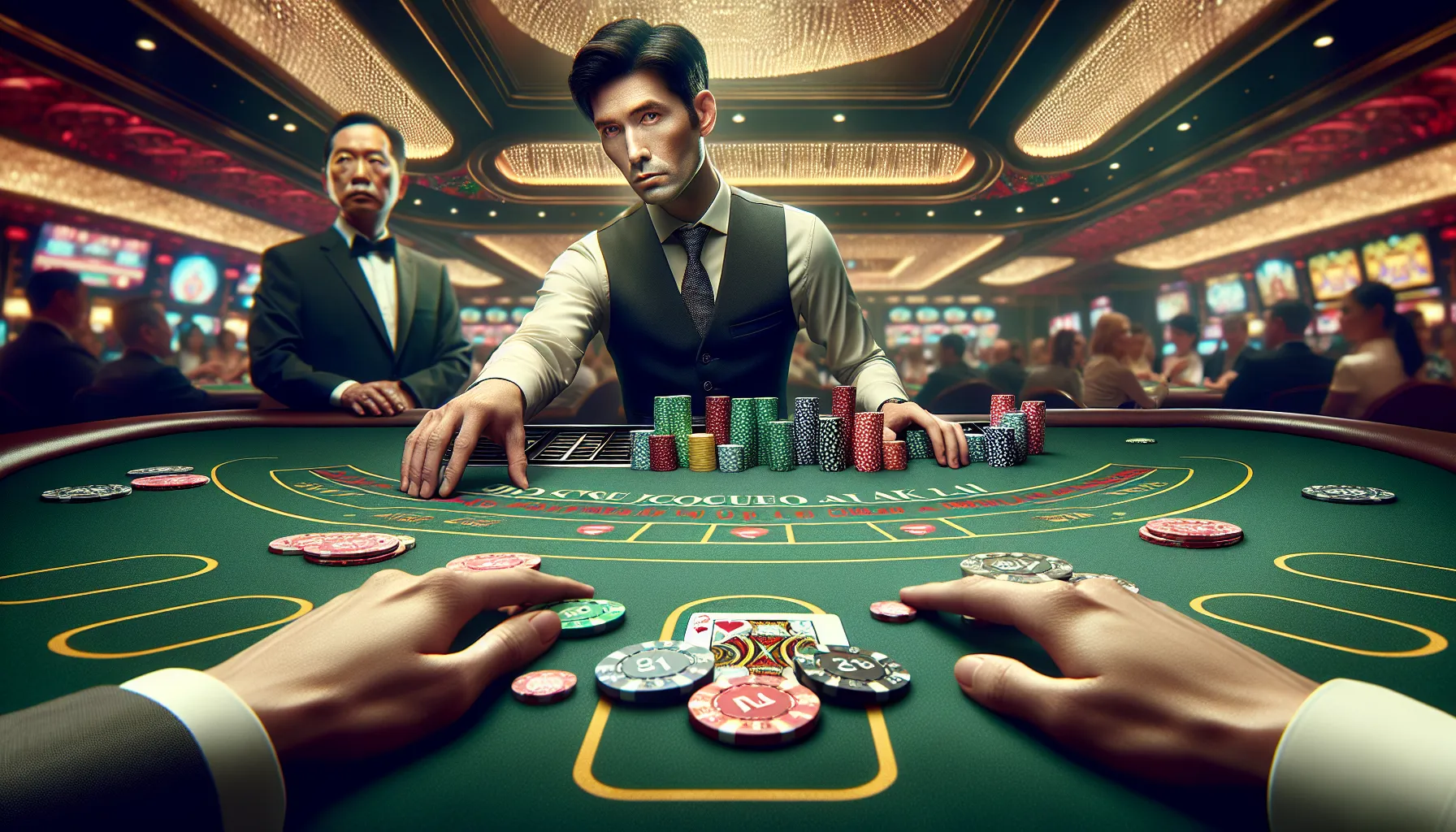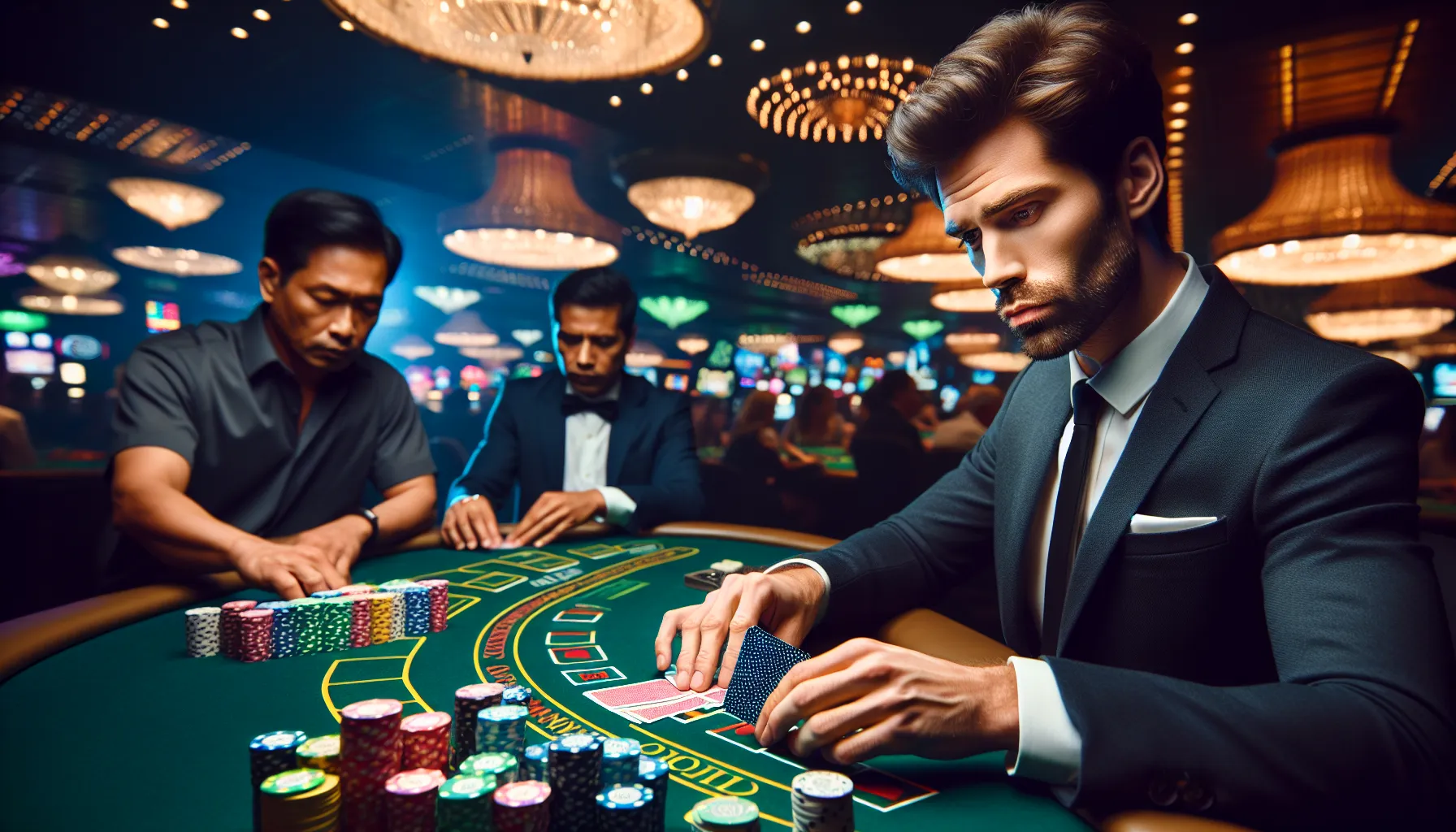Key Takeaways
- Hitting on 16 in blackjack depends on whether your 16 is hard or soft and the dealer’s upcard, making strategic decision-making crucial.
- A hard 16 carries a high risk of busting, with approximately 62% probability, while a soft 16 offers more flexibility due to the Ace’s adjustable value.
- When facing strong dealer upcards (7 or higher), hitting can reduce their advantage, whereas against weak upcards (2–6), standing might be a safer move.
- Alternatives like standing or surrendering can optimize outcomes, particularly when the dealer’s upcard strongly dictates unfavorable odds.
- Familiarizing yourself with basic strategy charts equips you with statistically optimal choices, improving your long-term success at the table.
- Effective risk management and disciplined decision-making are key to confidently handling challenging hands, such as holding a 16 in blackjack.
Blackjack’s one of those games that’s as thrilling as it is strategic. Every decision matters, and one of the trickiest spots to be in is holding a 16. It’s that uncomfortable middle ground where you’re just a step away from busting, but standing might feel like giving up. I’ve been there, staring at the dealer’s upcard, wondering if hitting is the right move.
The truth is, there’s no one-size-fits-all answer. It all depends on what the dealer’s showing and whether you’re playing with a hard or soft 16. But don’t worry—once you understand the logic behind the moves, it’s easier to make the right call. Let’s break it down so you can approach that 16 with confidence the next time you’re at the table.
Understanding The Basics Of Blackjack
Blackjack combines skill and strategy, requiring players to balance risks and rewards during every hand. Knowing the basics helps players make informed decisions and improve outcomes.
The Importance Of Decision Making In Blackjack
Every decision impacts the chances of winning, whether it’s standing, hitting, splitting, or doubling down. Making strategic moves based on the dealer’s upcard and your hand ensures better odds. For example, standing on 17 against a dealer’s low upcard reduces the probability of busting while leveraging the dealer’s potential mistakes. Poor decisions, like hitting unnecessarily, increase risks and reduce long-term profitability.
What Does “Hitting On 16” Mean?
Hitting on 16 involves drawing another card when your hand totals 16, which can be risky due to the high chance of busting. If the dealer shows a strong card, like 9, 10, or Ace, hitting may increase your chances of reaching closer to 21. However, on a soft 16 (a hand with an Ace valued as 11, like Ace-5), the risk decreases because the Ace can adjust to prevent a bust. Understanding the hard and soft 16 distinction is essential for making smart choices.
Analyzing The Risks Of Hitting On 16

Hitting on 16 carries significant risks, as the chances of busting are higher compared to other totals in blackjack. Understanding probabilities and how the dealer’s strategy influences outcomes is key for informed decision-making.
The Probability Of Busting
The odds of busting when hitting on a hard 16—where no ace is counted as 11—are approximately 62%. This happens because drawing a card valued at 7 or higher pushes the total over 21. For example, if you hold 10 and 6, drawing 7 causes a bust. In contrast, a soft 16—such as Ace and 5—has flexibility to avoid a bust since the ace can shift to a value of 1 if necessary. Recognizing when the risk is lower, like when holding soft totals, improves your long-term success.
Dealer’s Advantage And Strategy Considerations
Dealers follow strict rules, such as hitting until they reach at least 17. When their upcard is strong, such as 7 or higher, their chances of building a winning hand are greater, increasing the pressure to act on your 16. Against weaker dealer cards like 4, 5, or 6, standing becomes a safer move since the probability of the dealer busting rises under these conditions. Combining basic strategy with consideration of dealer tendencies helps optimize each decision.
When You Should Hit On 16 In Blackjack

Hitting on a 16 in blackjack often depends on the situation. By assessing the dealer’s upcard and understanding key strategic factors, it’s possible to make smarter decisions at the table.
Situational Factors To Consider
Situational factors influence whether hitting on a 16 is the optimal move. A hard 16, made up of cards like 10, 6 or 9, 7, carries a higher risk of busting when taking another card. In contrast, a soft 16, such as Ace, 5, offers flexibility, as any additional card can’t lead to an immediate bust.
The total value of your 16 should always be evaluated against the dealer’s upcard. For instance, against dealer’s strong cards like 7, 8, 9, 10, and Ace, taking a hit can reduce the dealer’s advantage in the long term. Against weaker upcards, such as 4 or 5, standing minimizes your risk, letting the dealer’s hand potentially bust. Each decision requires balancing potential outcomes with the known probabilities.
Understanding The Dealer’s Upcard
The dealer’s upcard largely dictates your strategy on a 16. Strong upcards (7 or higher) indicate a higher probability that the dealer will reach a strong total like 17 or more. When facing these, hitting becomes a strategic move to improve your total, even with the risk of busting.
Weak dealer upcards (2 through 6) increase the likelihood of the dealer busting if they’re forced to hit multiple times. In these cases, standing on 16 improves your odds, as the dealer may fail to reach 17. Properly interpreting the dealer’s upcard is essential for timing your hits or stands effectively.
Alternatives To Hitting On 16

Making decisions on a 16 in blackjack often depends on strategy and situation. Exploring alternatives like standing or surrendering can improve outcomes and minimize risks.
Choosing To Stand Instead
Standing on a 16 works best against a dealer’s weak upcard, such as 2 through 6. These cards increase the dealer’s chances of busting, especially under the “must hit until 17” rule. By standing, I avoid the high bust probability of a hard 16, approximately 62%. For example, if the dealer shows a 5, choosing to stand can force them into risky draws, boosting my chances of winning.
Opting to stand might also work when I hold a hard 16 and the dealer’s upcard shows a moderate risk, such as a 7 or 8. Although these situations involve uncertainty, standing helps limit losses compared to risking a bust by hitting.
When To Surrender
Surrendering becomes an optimal choice with a hard 16 against strong dealer upcards, like 9, 10, or Ace. These upcards suggest high odds of the dealer reaching a winning total, making further action less favorable. By surrendering, I forfeit half my bet but preserve the rest, turning a likely full loss into a partial one.
This strategy is most effective when late surrender is permitted, allowing me to assess the dealer’s potential score before deciding. For instance, with a 10-6 against a dealer’s face card, surrendering can mitigate the risks that come with hitting or standing.
Expert Tips For Making A Smart Decision
Taking the right approach when deciding whether to hit on 16 in blackjack can make a significant difference to your success. I focus on strategies that balance risk and reward while enhancing your decision-making skills.
Familiarizing Yourself With Basic Strategy Charts
Learning basic strategy charts is key to improving your blackjack results. These charts show the statistically optimal move for every hand combination based on the dealer’s upcard. Studying them helps me determine when hitting on 16 is beneficial, such as against a dealer’s high-value cards (7 through Ace), where the risk of standing often outweighs the risk of hitting. I also use these charts to recognize situations where standing, surrendering, or even doubling down is a better option.
Many casinos adhere to standard rules reflected in these charts, so they remain a reliable tool in most games. By applying what I’ve learned, I avoid relying solely on guesswork, instead making consistent, logical choices.
Managing Risk And Staying Disciplined
Minimizing losses starts with disciplined decision-making. I never let emotions dictate my move, particularly when faced with a tough hand like 16. Instead, I evaluate probabilities and focus on long-term gains rather than immediate outcomes.
It’s also essential for me to stick to my budget, ensuring I don’t overbet in pursuit of recovering losses. A pre-set limit keeps me grounded, allowing for calculated moves even under pressure. Proper risk management enables me to confidently navigate difficult decisions, including whether to hit on a 16.
Conclusion
Deciding whether to hit on 16 in blackjack can feel like a tough call, but it all comes down to understanding the situation and using strategy to your advantage. By considering the dealer’s upcard, the type of 16 you have, and the potential risks, you can make smarter choices that improve your chances at the table.
Remember, blackjack is as much about skill and discipline as it is about luck. Stay calm, stick to a solid strategy, and don’t let emotions guide your decisions. With practice and a clear understanding of the game, you’ll feel more confident handling those tricky 16s.
Frequently Asked Questions
What does a “hard 16” and “soft 16” mean in blackjack?
A hard 16 contains no Ace, or the Ace counts as 1 to avoid busting. A soft 16 includes an Ace counted as 11. The flexibility of a soft 16 reduces the chances of busting, while a hard 16 is more rigid and riskier.
Should I hit or stand on 16 in blackjack?
It depends on the dealer’s upcard and whether your 16 is hard or soft. Hit against strong dealer cards (7, 8, 9, 10, Ace) to reduce the dealer’s edge. Stand against weak dealer cards (2-6) to let the dealer risk busting.
What is the bust risk when hitting on 16?
Hitting on a hard 16 carries approximately a 62% chance of busting. With a soft 16, the risk is much lower, as the flexibility of the Ace allows for adjustments to avoid going over 21.
When should I surrender on 16?
Surrender is advisable when facing a dealer’s strong upcards (9, 10, Ace), especially in late surrender games. This move forfeits half your bet but minimizes potential losses in unfavorable scenarios.
How does the dealer’s upcard influence my decision?
If the dealer shows a weak card (2-6), standing on 16 is safer due to their higher bust probability. Against strong upcards (7-Ace), hitting can reduce the dealer’s advantage, though the risk of busting increases.
Why is following a blackjack strategy chart important?
A strategy chart provides statistically optimal moves for each scenario, helping you minimize losses and maximize wins. It simplifies decision-making by removing guesswork and emotional bias at the table.
Can I improve my chances of winning with a 16?
Yes. Familiarize yourself with basic strategy charts, assess the dealer’s upcard, consider surrendering against strong cards, and avoid emotional decisions. Proper bankroll management and discipline are also key to success.
Why is standing on 16 sometimes better than hitting?
Standing on 16 is safer when the dealer shows a weak upcard (2-6). In these cases, letting the dealer play out their hand can force them into risky draws, potentially resulting in a bust.
What are some common mistakes when playing a 16 in blackjack?
Common mistakes include always hitting on 16, misjudging the dealer’s upcard, ignoring strategy charts, and making emotional decisions. Each move should be based on the probabilities and risks involved, not instinct alone.
Can I win consistently with a 16 in blackjack?
While holding 16 is challenging, using the right strategies tailored to the dealer’s upcard and scenario can improve your odds. However, blackjack involves inherent luck, so winning consistently is not guaranteed, even with the best strategies.



